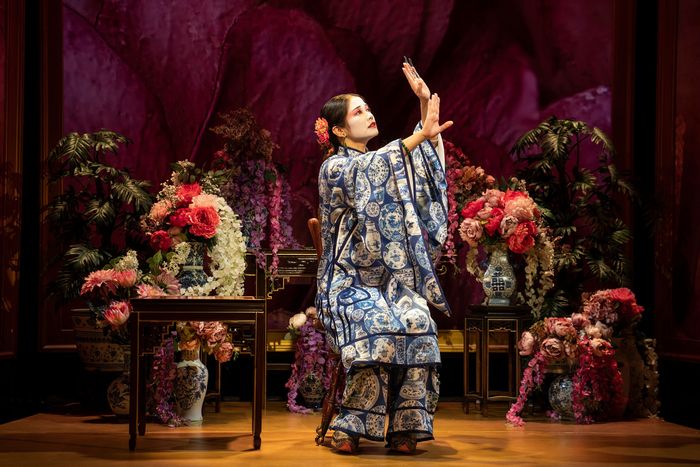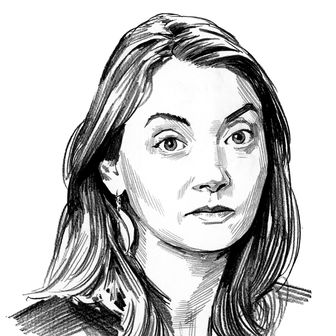
In The Chinese Lady, Lloyd Suh dramatizes the real story of the (possibly) first Chinese woman to travel to the United States. Suh is working from only a little information: We know that in 1834, the Carne brothers brought a teenage Afong Moy (likely not her real name) from Guangzhou to New York, where they used her as a promotional gimmick for their displays of Asian goods. Though she was supposed to stay for only a year or two, her managers did not let her go home. Instead, she remained in the public eye for almost two decades. She appeared at the American Museum as a cultural curiosity, went on a national tour, and eventually signed on as a living exhibit with P.T. Barnum. Touted as an “unprecedented novelty,” she drew crowds who wanted to see her demonstrate Chinese refinements, including tea preparation and, of course, how she could walk on her tiny bound feet.
Suh uses this real story as the armature for his instructive, occasionally devastating play. Onstage is a version of the display room used by the Carne brothers, an elevated place where Shannon Tyo — playing Afong Moy with a dazzling combination of warmth and remove — can address us. Her translator, Atung (Daniel K. Isaac), draws back the curtain to reveal her, and she immediately begins to chat about her life optimistically and cheerfully. She is annoyed with Atung for his passive aggression (“Atung is irrelevant!” she sings out, which he agrees with), and the two of them have a smiling, barbed conversation. When he talks directly to us, Isaac steers hard into every head-bobbing, eager-to-please Asian stereotype. It’s deliberately awful, most painful when the audience laughs.
Every time Atung draws the curtain after Afong Moy’s short exhibition of tea and walking, years leap past. In the next scene, she is still in her room, a little older but still optimistic, full of grand plans to return to China. She could bring back a white girl to further cultural understanding, she thinks. Atung closes the curtain. Atung opens the curtain. She seems less enthusiastic as she pours the tea, though she’s still smiling. Decades go by; she never leaves.
Suh and director Ralph B. Peña premiered The Chinese Lady in 2018, produced by Peña’s group the Ma-Yi Theater Company. Now Ma-Yi has brought the production to the Public Theater, currently producing a two-show microseason celebrating Asian American artists. In the Public’s Martinson Theater, the National Asian American Theatre Company is presenting a set of monologues (by writers including Sam Chanse and Naomi Iizuka) performed by actors over 60. Perhaps unintentionally, the collection’s title — Out of Time — is a little rich: Even when excellent, five half-hour solos makes for a long production. But in the moments that The Chinese Lady became almost too painful to bear, it comforted me, obliquely, that those elders were there, across the hall and up the stairs, keeping her lonely vigil company.
I saw The Chinese Lady in that first production in 2018. It had the same cast and director — but it looked quite different. In the premiere, set designer Junghyun Georgia Lee imagined Afong Moy’s room as a wallpapered chinoiserie jewel box, the peacock-blue walls painted with flowers and an out-of-place toucan, while her costumes dressed Tyo in boxy, period-appropriate quilted silks. The room was thus a sly record of failed efforts to be historically “accurate,” both by the production and by the Carnes. The Public revival approaches the mise-en-scène more impressionistically. In 2022, Linda Cho replaces Lee as costume designer, and Tyo now wears a robe with deep sleeves, printed all over with images of blue-and-white dishes. In this deliberately unhistorical outfit, Afong Moy becomes a visual pun (she’s wearing “china”) while sitting in a new set (again by Lee) with abstract oversize petal images on its walls. These look blobby and sterile, the kind of thing you see in hotel art. There are also a series of projections, slides about anti-Asian hate, which get a little bit TED Talk. The production has lost a good portion of its loveliness with these changes. It has lost its visual tartness and humor, too.
Suh’s careful stitching, though, has not pulled loose over the years. He balances workplace comedy — we’ve all worked with an Atung! — and swift, excoriating bitterness with a measuring hand. And Peña again directs beautifully shaped performances from Tyo and Isaac, who have polished their roles to a deep sheen. Their interplay is so perfect, it’s musical: She rushes headlong, so he drawls his lines, interrupting her rhythms. Every time she picks up verbal speed, he’s there with a metaphorical clothesline. It’s a whole comic acrobatic act, performed with Isaac sitting rigid at the curtain’s edge, Tyo completely still in her chair in the box. (This humor makes Atung’s eventual pity for her even more agonizing, not to mention his pivot from the performer’s early-play minstrelsy to something more three-dimensional and weary.) The production does not resist the voyeurism Suh is critiquing, so, for instance, we get a demonstration on a lifelike wax foot of the break-and-bind technique that so titillated U.S. gawkers. The play becomes more disturbing as we’re forced to link the Carne brothers’ project — in which commercial relationships were described as paths to understanding — and the production itself, in which art has replaced marketing as the liberal delusion.
Using 190-year-old newspaper accounts and advertisements to track a life can be tricky, so there are silences and holes in the text. What happened to Afong Moy? No one knows. What happened to Atung? Instead of inventing answers, Suh leaves us with questions. And by putting the “Chinese Lady” back in front of an audience, he raises further questions about the harms done by watching, even the harms done by continuing to beg a white audience for its attention. Afong Moy believes that she has a mission — she, like other artists we could mention, keeps trying to defeat callousness and hatred with performance. In a wrenching sequence near the play’s end, Afong Moy tells us she has not fulfilled her purpose. As she lists centuries of anti–Asian American atrocities and state-sponsored racism, she apologizes again and again. “Perhaps if I had been more worthy of the task. If I had shown you more of myself,” she says, taking responsibility for other people’s sins. “I am so, so sorry.” It’s here that the play begins to plead directly with an audience it clearly assumes is largely non-Asian. “Can you see me?” she asks in her final moment onstage. Does this kind of please-perceive-us entreaty work? A hundred and eighty-eight years argues that it’s time for a different tack. It may be relevant — horribly relevant — that the Public has reported that a dancer in The Chinese Lady’s first-night celebration was attacked on his way to the theater. He was hurt, but he still performed. The curtain closes, the curtain opens.
The Chinese Lady is at the Public Theater through April 10.


